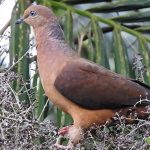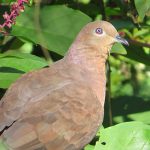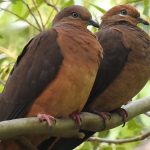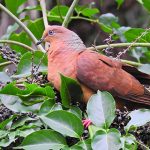BROWN CUCKOO-DOVE
The Brown Cuckoo-Dove
The Brown cuckoo-dove is a graceful, medium-sized bird that blends elegance with a quiet presence in the forest. Measuring around 40–48 cm in length, it is instantly recognisable by its long, tapering tail, which is tipped with narrow bands of white. This tail, held steady in flight, adds to its streamlined silhouette as it glides between trees.
Its plumage is predominantly brown, but sunlight can reveal subtle variations—from warm chestnut tones to deeper chocolate shades—depending on the bird’s age, sex, and the light conditions. The feathers often have a soft, silky sheen, giving the bird a refined appearance. Most striking of all are its deep crimson eyes, glowing like tiny jewels against the earthy tones of its feathers.
Distribution and Habitat
The Brown cuckoo-dove enjoys a broad distribution across eastern Australia, as well as New Guinea and nearby islands. In Australia, it is most commonly found from Cape York Peninsula in Queensland down through New South Wales and into eastern Victoria.
It thrives in:
- Rainforests – both tropical and subtropical
- Wet sclerophyll forests
- Wooded gullies and coastal scrub
- Occasionally, gardens and orchards near forest edges
These birds favour areas with dense vegetation, where they can forage for fruit and remain well-hidden from predators.
Voice and Communication
The Brown cuckoo-dove’s call is a low, resonant “coo-oo… coo-oo…”, repeated rhythmically and often carrying far through the trees. Unlike the short coos of some pigeons, their call is drawn-out and almost mournful, yet melodious. During the breeding season, this vocalisation becomes more frequent, serving both to attract mates and to mark territory.
Diet and Ecological Role
This species feeds primarily on fruits and berries, favouring those of native shrubs, vines, and small trees. It is equipped with a specialised crop, enabling it to store large amounts of fruit before digesting them.
This feeding behaviour plays a vital ecological role:
- Seed dispersal: The seeds of many rainforest plants pass through the bird unharmed and are deposited far from the parent plant, helping forests to regenerate and expand.
- Seasonal foraging: By moving across habitats in search of fruiting plants, Brown cuckoo-doves help maintain plant diversity over wide areas.
Breeding and Nesting
During the breeding season, which often coincides with times of abundant fruit, the Brown cuckoo-dove constructs simple, flimsy platform nests of twigs and leaves, usually placed in the fork of a small tree or shrub.
- Clutch size: Typically 1 white egg
- Parental care: Both male and female share incubation duties and later feed the chick a nutrient-rich secretion known as “pigeon milk” before gradually introducing regurgitated fruit.
- Fledging: The young bird remains in the nest for several weeks before taking its first flight.
Behaviour and Movement
Brown cuckoo-doves are often observed alone, in pairs, or in small, loose flocks. They are agile in flight, with strong, direct wingbeats, and can cover considerable distances between feeding sites. On the ground, they move with deliberate steps, often pausing to watch for danger before resuming their search for fallen fruit.
Conservation Status
The Brown cuckoo-dove is currently classified as Least Concern by the IUCN. Its population remains stable thanks to its adaptability and broad range. However, like many forest-dependent birds, it could be affected by:
- Habitat loss from land clearing
- Invasive plant species altering fruit availability
- Climate change affecting seasonal fruiting cycles
Safeguarding native forests—both large tracts and smaller habitat corridors—will help ensure the long-term survival of this species.
A Glimpse into the Forest
Imagine walking through a mist-laden rainforest at dawn. The air is cool and scented with damp earth and the faint sweetness of ripe berries. From somewhere deep in the green canopy, a slow, resonant “coo-oo… coo-oo…” repeats, its sound both calming and mysterious. A movement catches your eye—there, gliding between two fruiting trees, is a slender brown bird with a tail that seems almost too long for its body. It lands silently, crimson eyes scanning the branches for the next meal. In that moment, you witness not just a bird, but a quiet gardener of the forest, carrying the seeds of life from one corner of the wilderness to another.




